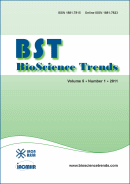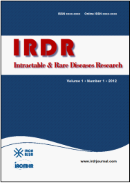Drug Discov Ther. 2023;17(5):312-319. (DOI: 10.5582/ddt.2023.01069)
Elevated indoleamine 2,3-dioxygenase activity is associated with endothelial dysfunction in people living with HIV and ROS production in human aortic endothelial cells in vitro
Yang J, Cai R, Xun J, Zhang R, Li L, Shen Y, Qi T, Wang Z, Song W, Tang Y, Sun J, Xu S, Zhao B, Lu H, Chen J
The precise role of indoleamine 2,3-dioxygenase (IDO) in cardiovascular diseases (CVD) among people living with HIV (PLWH) is still under debate, despite recognized links. This study aimed to investigate the impact of elevated IDO activity on endothelial dysfunction in PLWH. A total of 38 PLWH, who had not previously received anti-retroviral therapy (ART), were enrolled in the study. These participants were monitored for 36 months following the initiation of ART. Measurements including plasma levels of IDO activity, markers of endothelial dysfunction, inflammatory factors, and lipids. In vitro, human aortic endothelial cells (HAEC) were exposed to interferon-γ, an IDO inhibitor, a kynurenine 3-hydroxylase (KMO) inhibitor, as well as different concentrations of kynurenine. Pre- ART, PLWH demonstrated notably elevated plasma concentrations of soluble intercellular adhesion molecule 1 (sICAM-1), soluble vascular cell adhesion molecule 1(sVCAM-1), and IDO activity in comparison to healthy controls. Post-ART, both IDO activity and sICAM-1 levels experienced a significant decrease, with IDO activity reaching levels comparable to those observed in healthy controls. Furthermore, a positive correlation was observed between IDO activity and sICAM-1 (p = 0.0002), as well as sVCAM-1 (p < 0.0001) before ART. In vitro, the augmentation of kynurenine concentration in the medium and the induction of IDO expression in HAEC resulted in increased production of reactive oxygen species (ROS), with minimal impact on endothelial dysfunction. From these findings, it can be concluded that long-term ART has the potential to restore the heightened IDO activity observed in PLWH. The overexpression of IDO primarily influences the expression of ROS in HAEC.







